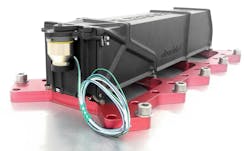Partnership manufactures satellite deployer using additive manufacturing
Alba Orbital (Glasgow, Scotland) provides support for PocketQube satellites by building platforms and providing parts and launch to other space companies around the world. As such, the company needed to build an updated version of its AlbaPod 2.0 PocketQube satellite deployer, improving on previous designs in terms of weight, manufacturability, and access, and incorporate a number of safety features.
Additive manufacturing specialist CRP Technology (Modena, Italy) has been working with Alba Orbital to build an updated deployer for PocketQube satellites. These miniature satellites, derived from an idea from Professor Robert J. Twiggs at Morehead State University (MSU; Morehead, KY) to build “a satellite that fits in your pocket,” are designed to carry out space research with lower launch costs compared to CubeSat satellites.
CRP has considerable experience supplying solutions for space key industry leaders using its patented Windform TOP-LINE composite materials. The selective laser sintering process and Windform XT 2.0 Carbon composite material have been chosen to guarantee the success of the project.
Most of the Windform TOP-LINE composite materials are suitable for space applications and have passed outgassing tests at NASA and ESA.
The Alba Orbital team said, “As the product needed to withstand a launch to space while containing several satellites, the pod needed to withstand high vibrations, and in the worst scenario, contain any satellite that breaks free internally. Windform XT 2.0’s toughness and strength make it a perfect candidate for this use case.”
In a short time, CRP manufactured AlbaPod v2, an extremely lightweight, flight-proven 3D-printed deployer for PocketQube compatible satellites, with a mass of <500 g.
“The most innovative aspect of the project,” Alba Orbital commented, “was the sheer number of components we switched over to Windform XT 2.0—not only was the shell redesigned in the material, but also the moving ejection mechanism and door assembly. Additionally, some parts are critically structural to the assembly as a whole.”
At the beginning of December 2019 for the Alba Cluster 2 mission, Alba Orbital launched six PocketQube satellites into orbit via the 3D-printed AlbaPod v2. Alba Cluster 2 has been in orbit for 100 days. A new launch with the 3D-printed AlbaPod v2 (Alba Cluster 3) is expected for later 2020.
For more information, please visit albaorbital.com and crptechnology.com.
